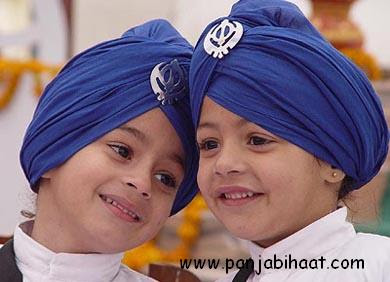Therefore keep this in mind: Dharam is not a small bypass. Dharam is a very great road. To explain to us with his enlightened wisdom, Guru Gobind Singh said, “Jale Hari, thale Hari, gufe Hari, gire Hari, oore Hari, bane Hari—God is in water, God is on land, God is in caves, God is in mountains, God is here, God is in forests.” [Dasam Granth p. 16] God is in all places.
Hair
Then there is the issue of our training. In what form are we to take the Khalsa into the world? Consider hair: It is not a foreign thing. Hair has come to us in the same way as other limbs of our body. To keep the hair, to take care of it, to respect it, is not a matter of great courage. It has come with our body, and just as we keep our hands and body washed, we are to keep our hair clean. It is the gift of God, just as other parts of our body are the gifts of God.
Actually, when hair, body, language, speech, and actions were well-formed, when a person’s body and thoughts both remained clean, and when outer symbols were associated with dharam, such people became Mahan Singh, Mani Singh, Dayala Singh. Nothing remained hidden in them.
It is written in Gurbani, “Kabira ek achanbha dekhea hire hat bikae; Banjan hare bahira kaudi badle jae—An amazing thing was seen in this man: That diamond was being sold in the market, but in the absence of a proper buyer, it was being sold for pennies.” [GGS 1372]
When that diamond was cut, it began shining, and courage and love entered such people. Those powers entered them which Guru Gobind Singh describes thus: “Jimi jaman ke bikhe samasat ek jot hai. Na ghat hai na badh hai na ghat badh hot hai—In the skies and on the earth, there is one perfect light. It neither increases nor decreases.” [Dasam Granth p. 26]
What is the difference between us and those people?
They were our Granthis, our Ragis, our Jathedars. These positions still exist; these labels are still current. We have retained the name of Khalsa as well. But what is a Khalsa? What is a Sikh?
A Sikh moves by the Power of God. Khalsa also has become the recognizer of that Light. But now there is no necessity for saying that Khalsa is such and such. We must become Khalsa in our practical life. Then our actions will reach the people. People are tired of listening to those who only talk, and they are tired of reading books. People are very wise: They see who is writing and who is speaking. Now we will have to make our speech and our actions one.
The powers which are ever alive are within us. They are alive today; they were alive millions of years before. We speaking by means of that Power. When the Power departs, our body will die. The person who recognizes the inner Power becomes Khalsa, becomes Sikh.
Bhai Gurdas Singh has written, “Gur sangat kini khalsa—The Guru has made the congregation Khalsa” [War 41].
Historically, when teachings were being shared, the masands—the preachers appointed by the Gurus from the time of Guru Amar Das—used to sit on a bed and the other Sikhs used to sit on the floor around them. Then some defects crept into the masands. After these defects appeared, Guru Gobind Singh made the congregation Khalsa: “These masands are giving you wrong teachings which are opposite to mine. Abandon them and come straight to me. Take my training, become good human beings, and live in the world.” Thereafter they proved what Khalsa is. When Khalsa was created, tyranny became frightened; the cruel and corrupt people became troubled. Thus the second meaning of Khalsa is that the power of evil thought decreases, and the glory of Khalsa is greatly increased.
-- to be continued...



No comments:
Post a Comment